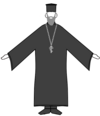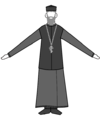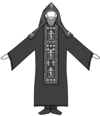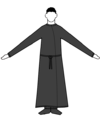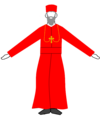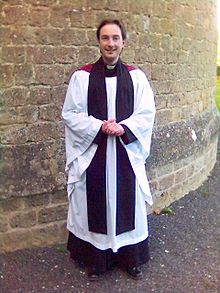Choral clothing

The vestments worn by church officials and liturgical services during the celebration of a divine service and during so-called pia exercitia (such as processions ) are referred to as choir clothing , choir clothing or choir costume . The exception is the celebration of Holy Mass , when the celebrants and the assisting deacons wear chasuble robes ( chasuble or dalmatic ). The choir clothing can be supplemented with insignia of the respective office in the church, for example the priest who is in charge of a celebration wears a stole , and at some celebrations the biretta to the choir robe for entering and leaving.
Choir Clothing may, in addition to Albe in accordance with the respective Episcopal Conferences also, acolyte , altar and other liturgical services that lay people are to be worn.
Historically, the choir clothing is derived from the robes that were in use in the last centuries of the Roman Empire . Choral clothing is mostly used in the Roman Catholic , Anglican, and Greek Orthodox Churches . Among the Protestant churches , apart from the Lutheran churches, they gave up choral clothing with the Reformation .
Choir clothing in the Roman Catholic Church
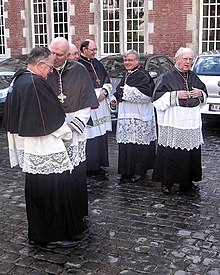
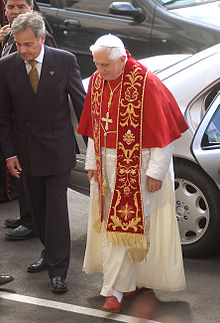

For the choir clothing of Roman Catholic clerics , detailed new regulations were made in some cases after the Second Vatican Council . The choir clothing mainly consists of:
- the cassock or gown with or without cingulate ; if the cleric belongs to a religious community that has a habit , he wears the tunic of the religious costume instead of the cassock .
- the choir shirt (or Rochett if the wearer is a prelate )
- possibly the biretta as headgear
Priests with papal honorary titles may wear a different cassock: black with purple trimmings, buttons and cingulate, while honorary prelates and apostolic protonotaries (Protonotarii Apostolici supra numerum) wear a purple cassock with scarlet borders and buttons and a purple cingulum. The previous requirement to wear a purple coat and purple stockings with buckled shoes was abolished with the Second Vatican Council . Honorary prelates and apostolic protonotaries wear a black cassock with amaranth-colored trimmings and buttons and the purple cingulum. Apostolic protonotaries of the papal curia (Protonotarii Apostolici de numero) , on the other hand, wear the purple cassock of a bishop with a Rochett and a purple mantle in the liturgy . Canons , if the respective cathedral chapter has papal permission to do so, can wear the Rochett with a mozzetta , the color of which is determined by the respective chapter.
Bishops wear a purple cassock with scarlet edging and their pectoral cross , which is attached to a green and gold ribbon or chain, a mozzetta over the rochetto and a purple pileolus (zucchetto) under the birett as headgear . Alternatively, bishops can also wear a black cassock with red trim (red buttons, buttonholes with red trimmings). Prelates and abbots of a territorial abbey , apostolic administrators and Apostolic Vicars must, even if they are not the episcopal ordination , have the choir dress wearing a bishop.
A cardinal wears a scarlet cassock with a pectoral cross on a red and gold ribbon or chain, a red mozzetta over the rochette and a red pileolus. The regulation common in earlier times to wear a mantle, the red cingulum with tassels, the tabarro (a liturgical cloak) and red buckled shoes has been repealed.
The Pope's choir clothing consists of a white cassock and a Rochett. In summer the Pope wears a red mozzetta made of silk, in winter one made of velvet with a white fur trim or during Easter a white mozzetta made of damask , also with a white fur trim. The last two variants were used by the Popes up to Paul VI. used and under Benedict XVI. reintroduced. The Pope's pectoral cross is attached to a gold chain.
The choir cloak (the cope ) and the stole can be worn over the choir clothing, for example when a cleric watches over the dispensing of the sacraments (e.g. at church marriage, if this does not take place during a Holy Mass), at church funeral ceremonies or when the latter presides over the hours of prayer (e.g. the presiding priest who presides at the celebration of Vespers in a seminary can wear the cope and stole over the choir clothes).
| Pope | cardinal | bishop | priest | Apostolic protonotary de numero of the papal curia |
Papal Honorary Prelate or Apostolic Protonotar supra numerum |
| Choir robes of various canons |
Choral clothing in the Eastern Churches
The choir clothing in the Eastern Catholic Churches , the Orthodox Churches and the Ancient Near Eastern Churches is relatively similar. A long-sleeved, mostly black outer cassock is worn over an inner cassock ( Greek ζωστικο , Zostikon or Russian подрясник , Podryasnik ) ( Russian ряса , Ryassa , Greek εξώρασον , Exorason ). Especially in the Greek tradition, instead of the exorason, often only a vest ( Greek κοντόρασον , Kontorason ) is worn. In the Russian Orthodox Church , married clerics often wear gray clothes while monks wear black robes. During the Easter season yet often under the guise alb worn. Some Russian metropolitans wear a white cassock as an undergarment and a blue one over it when celebrating the Divine Liturgy .
Eastern Catholic Churches and Orthodox Churches
In the Eastern Catholic Churches and Orthodoxy, monks wear a long black cape, the mantija (мантия, μανδύας), which covers all clothing worn underneath. In the Greek tradition, the mantija is only worn on certain liturgical occasions. In the Slavic church tradition all contribute monks and nuns of the rank of Stavrophor ( "cross-bearer"), the Mantija in all services within his own monastery. The mantija of a hegumen (abbot) is made of black silk, that of an archimandrite or bishop is made of colored silk with four square fields, two of them in the chest / neck area and two at the foot end. The mantija also has three horizontal stripes that are either gold (Greek tradition) or red and white (Slavic tradition).
The celibate clergy wear different headgear than the married ones. Cleric married carry either a colored kalimavkion or Skufia while Monks a black kalimavkion with corresponding head cape ( Epanokalimavkion ) , together as Klobuk referred to wear. Russian archbishops wear a jeweled cross on the front of their klobuk, Russian metropolitans wear a white klobuk, also with a jeweled cross. Many Orthodox patriarchs wear a rounded headgear, the koukoulion .
Priests who have been awarded a silver, gold or jeweled pectoral cross wear this with their choir clothes. Bishops wear a panagia (an icon of Theotókos , the Mother of God ) instead of the pectoral cross . Archbishops can wear both. All leading bishops and also some lower-ranking bishops have the right to wear an encolpion ( half-length portrait with the icon of Christ), a pectoral cross and a panagia .
Examples
Different clothing traditions exist within the different autocephalous churches. The following pictures show examples of choral clothing in the Eastern Churches.
| Patriarch (slavic) |
Metropolitan (Slavic) |
Bishop (slavic) |
Bishop (greek) |
| Priest in liturgical robe for Vespers |
Priest (in the Orthodox churches the priests and priest monks also wear a pectoral cross ) |
Priest monk in exorason with Klobuk | Priest in a gray Zostikon and a black office room |
orthodox shima monk | Monk in exorason with Klobuk |
Lecturer in black Zostikon |
Oriental Orthodox Churches
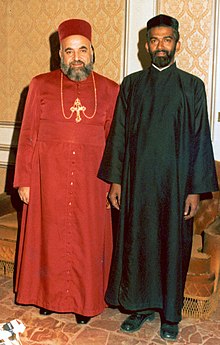
| Syriac Orthodox Patriarch |
Syriac Orthodox Bishop |
Syriac Orthodox priest |
Syrian Orthodox priest monk |
Coptic priest |
In the Syrian Orthodox Church of Antioch , priests wear a black headgear (phiro) , similar to the pileolus of the Catholic Church. When performing sacramental acts, the priests also wear their stoles, the epitrachelion .
Choral clothing in the Anglican Church
In the Anglican tradition, choral clothing usually consists of cassock, choir shirt and cape. As early as the 14th century, the Anglican choir shirt had established itself as the basic equipment of choir clothing. The Book of Common Prayer in the 1552 edition prescribed for the Anglican clergy only the clothing that is now known as Anglican choral clothing, including for the celebration of the Eucharist. The edition of 1559, under Queen Elizabeth I , added the so-called Ornaments rubric , which was taken over from the Book of Common Prayer 1662 and, according to some interpretations (especially by the later Oxford Movement ), the pre-Reformation for the mass instead of the choral clothing Chasuble allowed: the chasuble , the dalmatic , the tunicella , the alb , the amikt and the maniple . These garments were not in use until the 18th century, although the smoke cloak was worn in cathedrals and at high celebrations such as the coronation . With the Oxford Movement in the 19th century, these ancient liturgical elements found their way back into larger churches. In smaller churches, however, it was still customary to wear choir clothes at mass.
For priests and deacons, the robe is almost always black. The traditional Anglican gown is double-breasted, but many Anglican clergymen, especially those closer to the Catholic tradition, prefer a cassock, as is predominantly worn in the Latin Church. The gown is worn with a cingulum , which can be in the form of a sash or a simple belt. A choir shirt is worn over it, which is much longer than in the Catholic tradition. Traditionally a "academic is Cowl " (academic hood) worn around the shoulders and back, combined with a black cape that looks like a stole, but no, or a scarf. Some clerics carry small cups . The traditional headgear of the Anglican clergy is the Canterbury cap , which, however, is not worn during worship. The biret or a doctoral hat is also rarely worn.
At times, only a black gown was worn during Anglican morning and evening prayers and the wearing of the choir shirt was reserved for Holy Mass. This clothing tradition continues today in the Church of Scotland and other Reformed and Presbyterian churches.
Lecturers often wear a blue (England) or black (United States) cape on liturgical occasions. Various clothing traditions are used for lecturers at Holy Mass.
Anglican bishops usually wear a purple cassock. Over this, instead of the choir shirt, they wear the Rochett with a red or blue zimarra with matching sleeves, black cape and occasionally an "academic cowl". At Holy Mass they usually wear alb, stole and chasuble, if it is in accordance with the traditions of the parish, or a cope with miter with two loops that fall backwards. In dioceses or parishes that are more evangelically oriented, normal choir clothing is worn.
Anglican bishops usually wear a pectoral cross on a chain and a bishop's ring .
| bishop | Canon (color of cassock varies) |
priest | Editor |
literature
- James-Charles Noonan Jr .: The Church Visible: The Ceremonial Life and Protocol of the Roman Catholic Church. Sterling ethos; 2012; ISBN 1402787308
- Ut sive sollicite . Secretaria status seu papalis: Instructio: Circa vestes, titulos et insignia generis Cardinalium, Episcoporum et Praelatorum ordine minorum. In: Acta Apostolicae Sedis 61 (1969) 334-40 (dress code of the Roman Catholic Church, Latin / English)
- By instruction . Sacra Congregatio pro clericis litterae circulares: De reformatione vestium choralium. In: Acta Apostolicae Sedis 63 (1971) 314-15 and Notitiae 8 (1972) 36-37. (Roman Catholic Church Dress Code, Latin / English)
- Dress of Roman Catholic Clergy (English, with extensive bibliography)
- Nicodemus C. Schnabel: The liturgical vestments and insignia of the deacon, presbyter and bishop in the churches of the Byzantine rite. Echter Verlag, Würzburg; 1st edition, 2008. ISBN 3429030021
- John Abel Felix Prosper Nainfa: Costume of Prelates of the Catholic Church, According to Roman Etiquette. Original reprinted by Forgotten Books (2012). ISBN 1440049629 . (First edition was 1909, so it describes the situation before the Second Vatican Council )
- Janet Mayo: A History of Ecclesiastical Dress. Batsford Ltd; 1st edition (1984), ISBN 0713437642
- Christa Vets Vestments: Cassocks: Zostikon, Exorason, and Kontorason - Examples (photos) of Orthodox vestments (commercial)
Web links
- Canons (English)
- Collection of materials for clerical and religious headgear: Roman Catholic, Eastern Church, Evangelical Lutheran, Islamic, Jewish, Free Church, Tibetan Buddhist
Individual evidence
- ↑ General introduction to the missile AEM, 339
-
↑ Ut sive sollicite. Secretaria status seu papalis: Instructio: Circa vestes, titulos et insignia generis Cardinalium, Episcoporum et Praelatorum ordine minorum. In: Acta Apostolicae Sedis 61 (1969) 334-40. ( online with English translation )
By instruction. Sacra Congregatio pro clericis litterae circulares: De reformatione vestium choralium. In: Acta Apostolicae Sedis 63 (1971) 314-15 and Notitiae 8 (1972) 36-37. ( online with English translation )
Cæremoniale Episcoporum: ex decreto sacrosancti œcumenici Concilii Vaticani II instauratum auctoritate Ioannis Pauli pp. II promulgatum. In: Libreria Editrice Vaticana ( Vatican City ), 1984, reprints 1985 and 1995. ( online with English translation ) - ↑ Instruction Ut sive sollicite in Documents for the Renewal of the Liturgy , Vol. 1, Heinrich Rennings and Martin Klöckener (eds.), Butzon & Bercker, 1335, pp. 639ff
- ↑ A given color - The Red of the Cardinals: On the History of Insignia and Garments .
- ↑ Ut sive sollicite: Pars prima: De Vestimentis: C) Pro Praelatis ordine minoribus
- ↑ Ut sive sollicite: Pars prima: De Vestimentis: B) Pro Episcopis
- ↑ Ut sive sollicite: Pars prima: De Vestimentis: A) Pro SRE Cardinalibus
- ^ Simpson, John A. arts Surplice & Vestments in The New International Dictionary of the Christian Church JD Douglas (Ed.) Exeter: Paternoster (1974)
















